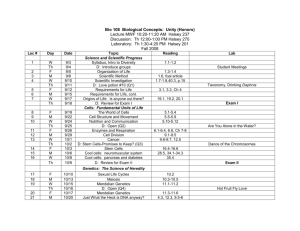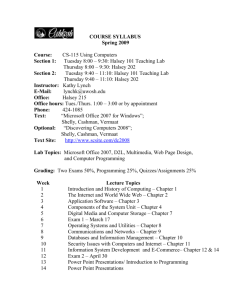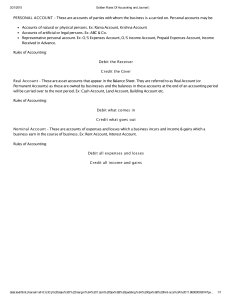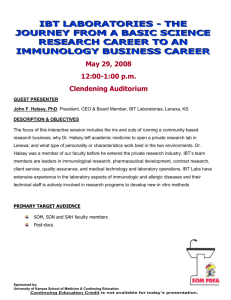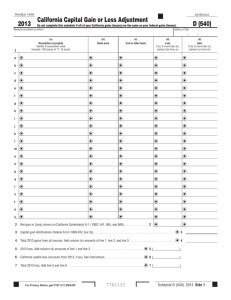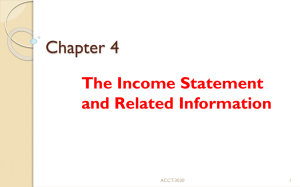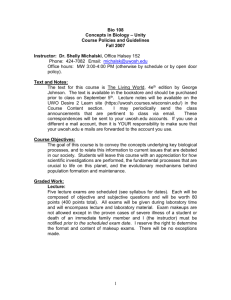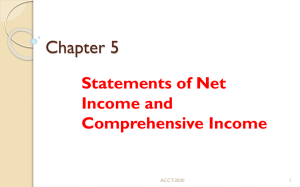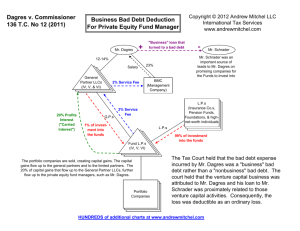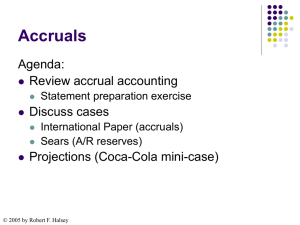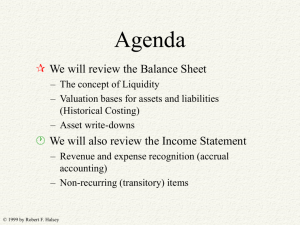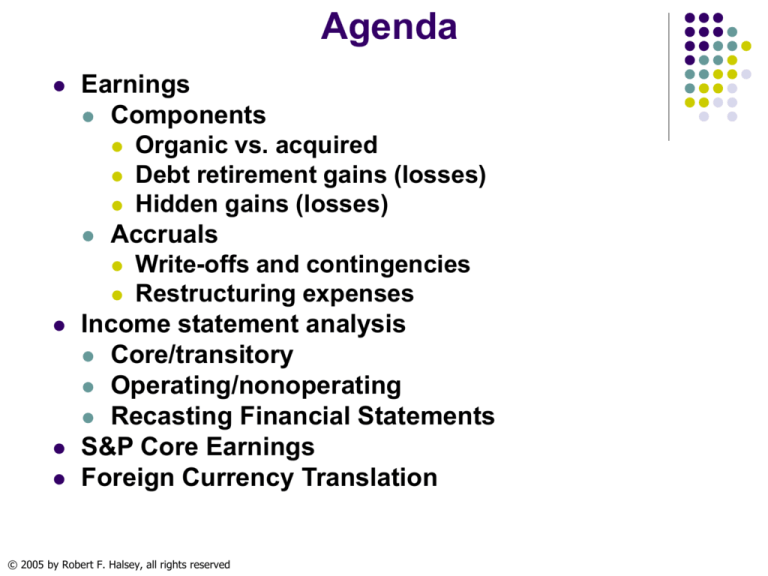
Agenda
Earnings
Components
Organic vs. acquired
Debt retirement gains (losses)
Hidden gains (losses)
Accruals
Write-offs and contingencies
Restructuring expenses
Income statement analysis
Core/transitory
Operating/nonoperating
Recasting Financial Statements
S&P Core Earnings
Foreign Currency Translation
© 2005 by Robert F. Halsey, all rights reserved
Organic vs. acquired Earnings - Target
CAPEX =$2.2b
($3b x 74%) in
2003, or
approximately
$22 million
($2.2b/ 101 new
stores) per new
store. Projections
of continued
sales growth at
the 2003 level
will, therefore,
entail similar
expenditures
unless we expect
retail markets to
improve.
© 2005 by Robert F. Halsey, all rights reserved
Debt Retirement Gains (Losses)
Bond and note liabilities are carried on the balance sheet at
historical cost (original issue price plus or minus any
unamortized premium or discount).
When such debt is repurchased in the open market or
acquired via a call provision, the difference between the
purchase price and the book value of the debt is recorded
as a gain or loss in the income statement.
Classification of these gains and losses as ordinary or
extraordinary items depends on whether they meet the test
for extraordinary items of being unusual and infrequent.
Although such gains and losses on debt repurchases are
reported in income, no gain or loss occurs in an economic
sense. Thus, such gains and losses are irrelevant for
income analysis. As a result, we must adjust income to
eliminate the effect of these gains and losses as part of our
prospective analysis.
© 2005 by Robert F. Halsey, all rights reserved
Hidden Gains - IBM Mini-Case
Sale of the Global Network. In December 1998, the company announced that it
would sell its Global Network business to AT&T for $5 billion. The IBM Global
Network generated revenues of approximately $1.2 billion in 1998.
During the third quarter of 1999, the company completed the sales of its
Global Network business in 34 countries for approximately $727 million,
bringing the year-to-date total to 38 countries and $4,919 million. More than
5,100 IBM employees joined AT&T as a result of these sales.
The company recognized a pre-tax gain of $586 million on the third-quarter
sales ($366 million after tax, or $.19 per diluted common share). The net
gain reflects dispositions of Plant, rental machines and other property of
$62 million and contractual obligations of $79 million.
Selling, general and administrative expense for the third quarter and first
nine months of 1999 decreased 13.7 percent and 11.2 percent, respectively,
from the same periods in 1998. The decrease in the third quarter of 1999 was
primarily driven by the net pre-tax benefit…associated with the sale of the
Global Network…The decrease in the first nine months of 1999 reflects the net
pre-tax benefit of $2,066 million associated with the sale of the Global
Network…
© 2005 by Robert F. Halsey, all rights reserved
IBM mini-case
As reported
SG&A expense
Total revenue
3 months
ended
9/30/1999
3 months
ended
9/30/1998
9 months
ended
9/30/1999
9 months
ended
9/30/1998
3,501
4,057
10,284
11,588
21,144
20,095
63,366
56,536
SG&A-to-total revenue
16.6%
20.2%
16.2%
20.5%
Growth in total revenue
5.2%
-----
12.1%
-----
3 months
ended
9/30/1999
3 months
ended
9/30/1998
9 months
ended
9/30/1999
9 months
ended
9/30/1998
As adjusted
SG&A expense
Total revenue
SG&A-to-total revenue
© 2005 by Robert F. Halsey, all rights reserved
4,087
4,057
12,350
11,588
21,144
20,095
63,366
56,536
19.3%
20.2%
19.5%
20.5%
Write-offs and contingencies
Write-offs:
Compare undiscounted cash flows with book value of
asset
If less, write down to present value of cash flows
Loss on W/D of assets
Asset
xxx
xxx
(I/S)
(B/S)
Contingent liabilities:
Record if probable and can be estimated
Expense
Liability
xxx
Restructuring Expenses
© 2005 by Robert F. Halsey, all rights reserved
xxx
(I/S)
(B/S)
Kellogg mini-case
1.
2.
3.
4.
5.
6.
7.
How much expense did Kellogg Company report in each of the last 3
years relating to restructuring activities?
How much of this expense in each year was paid in cash?
What are the principle areas of cost encompassed under the general
term of restructuring expense?
Do you feel that the character of these expenses is the same? That
is, as a financial analyst, how do you interpret the different types of
restructuring expenses?
Should restructuring expenses be ignored in interpreting financial
results? That is, should analysts look at income before restructuring
expense?
What effect does the write-off of an asset have on current income?
On future income?
Assuming that you choose not to ignore them, does the character of
the restructuring cost suggest possible ways to treat them in your
analysis of the company’s profitability?
© 2005 by Robert F. Halsey, all rights reserved
Kellogg mini-case
© 2005 by Robert F. Halsey, all rights reserved
Kellogg
mini-case
© 2005 by Robert F. Halsey, all rights reserved
P&G Restructuring Charges
• But even as P&G excludes the restructuring charges from
what it calls its "core net earnings," it includes gains from
selling brands, sales that some analysts and investors believe
should be treated as one-time events.
• Depending on investors' views of the charges and gains, P&G
earnings are either rising or falling.
• If you back out the gain, as does Tim Drake, a senior equity
analyst at Banc One Investment Advisors, in Columbus, Ohio,
P&G's core earnings actually dropped 7%, to $1.16 billion.
"Their business isn't manufacturing brands and companies to
sell. Their business is manufacturing products to sell.“
• “You can chastise the company for the way it puts a [news]
release out, but it is still the analysts' job to put some thought
into this issue and decide what should or shouldn't be
included."
© 2005 by Robert F. Halsey, all rights reserved
Income Statement Analysis
© 2005 by Robert F. Halsey, all rights reserved
© 2005 by Robert F. Halsey, all rights reserved
Recasting – a preview
Income Statement Adjustments
1. Removing transitory items such as:
•
Gains and losses on sales of assets (long-term and investments)
•
Transitory items below income from continued operations (discontinued operations,
extraordinary items, and changes in accounting principles)
•
Restructuring expenses
•
Gains on stock issuances by subsidiaries
•
Losses on write-downs of assets (long-term and inventories)
•
Merger costs
•
LIFO liquidation gains
•
Gains and losses on debt retirement
•
Liability accruals deemed excessive
•
Gains from reductions of deferred tax valuation allowance
2. Separating operating and non-operating items
•
Treating pension service cost as operating
•
Treating pension interest costs and expected returns as non-operating
•
Treating debt retirement gains and losses as non-operating
•
Treating short-term fluctuations in tax expense as non-operating
•
Treating income from equity method investments as non-operating
•
Adding expenses not reflected in income
1. Employee stock option expense
2. Inadequate reserves for bad debts
3. Reductions of R&D, advertising, etc., to achieve short-term income targets
© 2005 by Robert F. Halsey, all rights reserved
Recasting – a preview
Balance Sheet Adjustments
•
Capitalization of operating leases
•
Consolidation of equity method investments
•
Consolidation of variable interest entities (VIEs)
•
Elimination of discontinued segments
•
Write-down of impaired goodwill
Statement of Cash Flows Adjustments
•
Recast cash inflows from asset securitization, from operating cash flows to financing
•
Eliminate operating cash flows that relate to tax benefits from exercise of employee stock
options
•
Eliminate operating cash flow gains from excessive increases in accounts payable
•
Recast operating cash flows from discontinued operations to non-operating section
© 2005 by Robert F. Halsey, all rights reserved
S&P’s Core Earnings Definition
(e.g., Operating, not Persistent)
© 2005 by Robert F. Halsey, all rights reserved
Foreign Currency Translation
Relates to translation of I/S and B/S into $US
Choice of Functional Currency dictates
translation method (Current or Temporal)
Translation method dictates whether FX
gains (losses) are run though I/S or in OCI.
© 2005 by Robert F. Halsey, all rights reserved
Translation methods
Current rate method
balance sheet items (except capital accounts) are translated
at current exchange rates.
Income statement accounts are translated at average
exchange rates. Net unrealized gains (losses) are
accumulated in other comprehensive income and do not
affect current profitability until the subsidiary is sold.
Temporal method
monetary assets (liabilities) are remeasured at current
exchange rates, non-monetary assets (liabilities) at
historical exchange rates.
Income statements are translated at average exchange
rates except for expenses relating to non-monetary assets
(COGS and depreciation, for example), which are
remeasured at historical exchange rates. Unrealized gains
(losses) affect current profitability under this method.
© 2005 by Robert F. Halsey, all rights reserved
Translation method
Current Rate*
Temporal
Cash & Investments
current
current
Accounts receivable
current
current
Inventory
current
historical
Prepaid expenses
current
historical
PP&E
current
historical
Intangibles
current
historical
Current Liabilities
current
current
Deferred income
current
historical
L-T Debt
current
current
historical
historical
derived
derived
Dividends
historical
historical
Revenues
average
average
Expenses
average
average
COGS
average
historical
Dep’n/Amortization
average
historical
Capital stock
Retained earnings
Translation adj.
Remeasurement
© 2005 by Robert F. Halsey, all rights reserved
Gain (loss) in
OCI
Gain (loss) in net income
Foreign Currency Translation Exercise
© 2005 by Robert F. Halsey, all rights reserved
© 2005 by Robert F. Halsey, all rights reserved
Current Rate Example
Assume that a company begins operations with an infusion of €1,350,000 in cash
and uses €1 million to purchase PP&E. The opening balance sheet is, therefore,
(in €)
Cash
350,000
L-T debt
550,000
PP&E
1,000,000
Equity
800,000
Total assets
1,350,000
Tot Liabs & Equity
1,350,000
At the end of the year, the company’s equity has increased to €1,300,000.
Assume that the exchange rates of the dollar and euro (€ ) are as follows:
January 1
€1.05 = $1.00
Average
€1.02 = $1.00
December 31
€0.95 = $1.00
The translation gain (loss) can be computed as follows:
Gain on beginning net assets
€800,000 x [(1/1.05 – 1/0.95)] =
80,200
Gain on increase in net assets
€500,000 x [1/1.02 – 1/0.95)] =
36,120
Total translation gain
116,320
© 2005 by Robert F. Halsey, all rights reserved
Reported in OCI,
not reported in
current income
Temporal Method Example
Assume that a company begins operations with an infusion of €1,350,000 in cash
and uses €1 million to purchase PP&E. The opening balance sheet is, therefore,
(in €)
Cash
350,000
L-T debt
550,000
PP&E
1,000,000
Equity
800,000
Total assets
1,350,000
Tot Liabs & Equity
1,350,000
The net monetary position at the beginning of the year is a net monetary liability of
€200,000 (cash of €350,000 less L-T debt of €550,000). Assume that the net
monetary position of the company at the end of the year is a net monetary liability
of €500,000 for an increase of €300,000. Assume that the exchange rates of the
dollar and euro are as follows:
January 1
€1.05 = $1.00
Average
€1.02 = $1.00
December 31
€0.95 = $1.00
The remeasurement gain (loss) can be computed as follows:
Loss on beginning net monetary liability
€200,000 x [(1/1.05 – 1/0.95)] =
$(20,050)
Reduces
Loss on increase in the liability
Current
€300,000 x [1/1.02 – 1/0.95)] =
$(21,672)
period profit
Total remeasurement loss
$(41,722)
© 2005 by Robert F. Halsey, all rights reserved

